Not sure how to spend three days in Tokyo? You’ve come to the right place!
This Tokyo in 3 days itinerary will walk you through all the best things to do in this bucket list worthy city. I visited Japan twice and spent over two weeks in Tokyo, and these are my top suggestions if you only have three days.
From temples to karaoke bars, from neon signs to quiet parks, or from bustling fish markets to modern shopping streets, this three days in Tokyo itinerary really has it all.
I’ll walk you through how to get from one destination to the next, so you can forget about the logistics and make the most of your time there.
For 3 perfect days in Tokyo – keep reading!
Contents

Me at the Senso-ji Temple in Asakusa Tokyo, Japan
Essentials to book before you read on!
Best tours in Tokyo
Tsukiji Fish Market Food & Walking Tour
TeamLab Borderless Entrance Ticket
Anime, Manga, Games & Pop Culture in Akihabara
Best hotels in Tokyo
Budget: Dormy Inn Premium
Mid-range: The Gate Hotel
Luxury: Park Hotel Tokyo
Want to see more of Tokyo? Check out my YouTube video about it!
Day 1 in Tokyo
Asakusa
Start your 3 day Tokyo Japan adventure in the city’s most colourful neighbourhood. With a distinct old Tokyo style, Asakusa is where artisanal stores, homely cafes, and ancient temples meet.
Stroll around and soak in the lively atmosphere as you try different street food along the way. Keep a look out for the Tokyo Skytree and Sumida Park – two top attractions in the area.
Another thing that makes Asakusa special? It’s home to the ancient Buddhist Senso-ji temple, which is the oldest temple in the city.
The traditional architectural style of the temple is captivating, and the five-storey pagoda, known as the Thunder Gate, is something special. I suggest you join an Asakusa guided tour, so that you can learn about this areas unique history from a local guide.
Once you’ve seen the temple and had a wander around, hop on the metro’s Ginza Line towards Shibuya and ride to Ueno Station. You can get from the temple to Ueno Park in just 15 minutes!
Click here to book your guided walking tour of Asakusa!

The iconic Senso-ji Temple in Asakusa, Tokyo, Japan, standing against a clear blue sky

Senso-ji Temple in Asakusa, Tokyo, Japan, with tourists walking around its historic grounds.
Ueno Park
This lush city park is a great mid-morning stop. On your way into the park, you’ll be greeted by a statue of Saigo Takamori, just one of the memorable attractions of the park.
The park is home to lots of Tokyo’s most important museums, like the National Museum of Western Art, the Tokyo Metropolitan Art Museum, and the Ueno Zoo where you can get up close with pandas!
There are some quaint temples in the park too, like the Shinobazunoike Benten-do temple that’s on a little island in the Shinobazuno Pond, and the Ueno Toshogu Shrine.
If you’re in Tokyo in spring, you really have to come to Ueno Park and see the cherry blossoms.
Whether you’re there for nature or the museums, Ueno Park promises a few laid-back hours away from the city’s hustle and bustle.
Just outside the park, not far from the Shinobazuno Pond, you’ll find the Ameyoko neighbourhood. You can get there in less than 5 minutes’ walk.
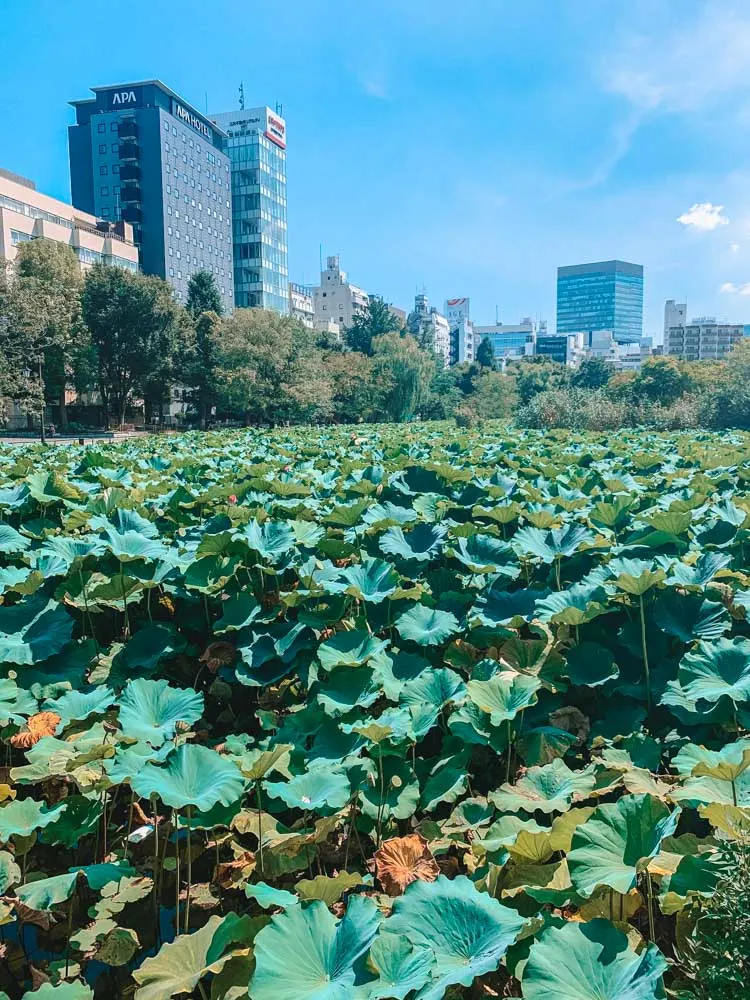
Ueno Park in Tokyo
Ameyoko & Americaya
A total contrast from the peaceful Ueno Park, Ameyoko is a busy neighbourhood known for its outdoor Ameya-Yokocho market. A fascinating place, the market is a feast for the senses.
With stores selling everything from electronics to clothes – it’s a great place for doing some window shopping.
The shops and stalls also have highly decorated, and sometimes bizarre, facades that are interesting to look at!
Grab some on-the-go lunch from one of the many street food stalls before heading onto Akihabara. These two must-visit areas neighbour each other, so you can walk from one to the other in about 15 minutes.
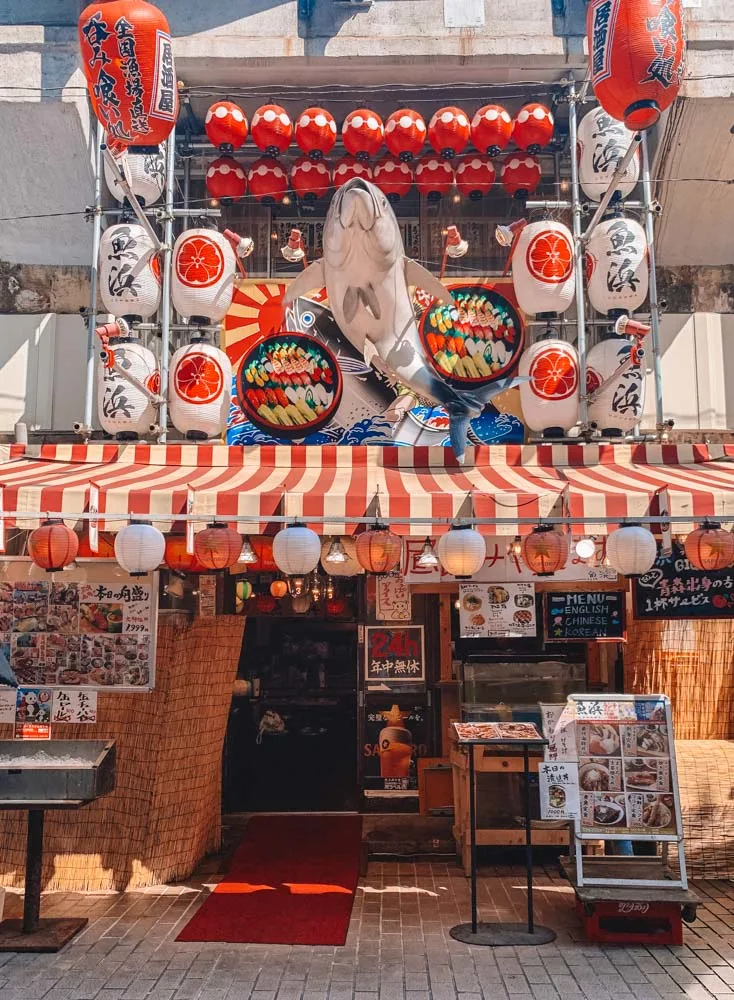
Funky shop fronts in Ameyoko, Tokyo
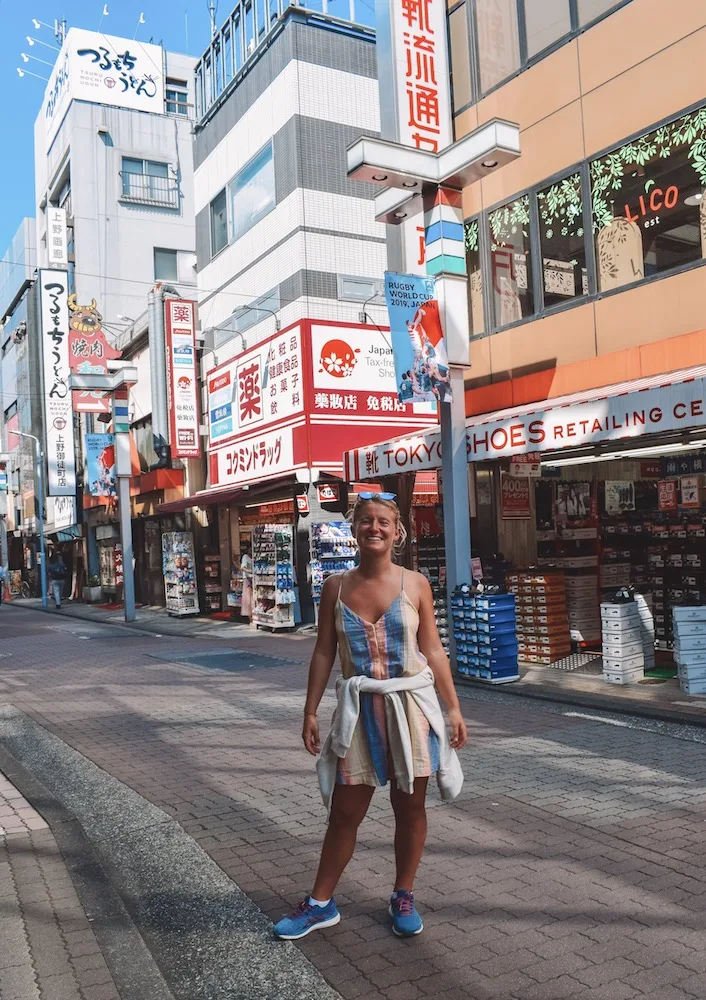
Exploring Ameyoko in Tokyo
Akihabara
Known as Tokyo’s “manga headquarter”, Akihabara is an eccentric neighbourhood that is renowned for its shopping. There are endless anime stores and electronic stores, which have given it its colloquial name “Electronic Town”.
Being a manga fan, I really enjoyed browsing the peculiar stores in Akihabara, and purchasing some manga in Japanese Kanji.
It’s also undeniable that manga has played an important role in the development of Tokyo’s more unique subcultures, so it felt like a sneak peak of something bigger.
If you really want to submerge yourself in the world of manga, head to the Tokyo Anime Center in Akihabara, or to the busy Mandarake Complex, which sells popular comics and collectable manga toys.
Honestly just walking around this unique neighbourhood is very fun, but if you want to do something really interesting, why not join a guided anime, manga and pop culture tour?
It will be a great way to learn how manga really blends with everyday life in Japan!
Click here to book your anime, manga, games and pop culture tour in Akihabara!
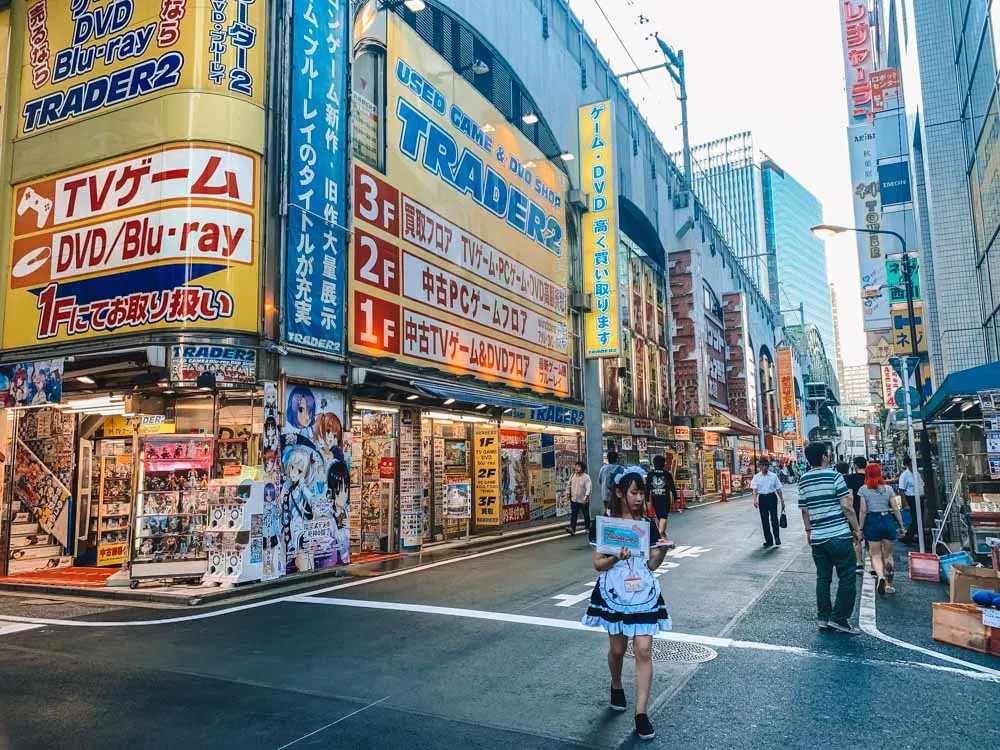
Exploring Akihabara in Tokyo
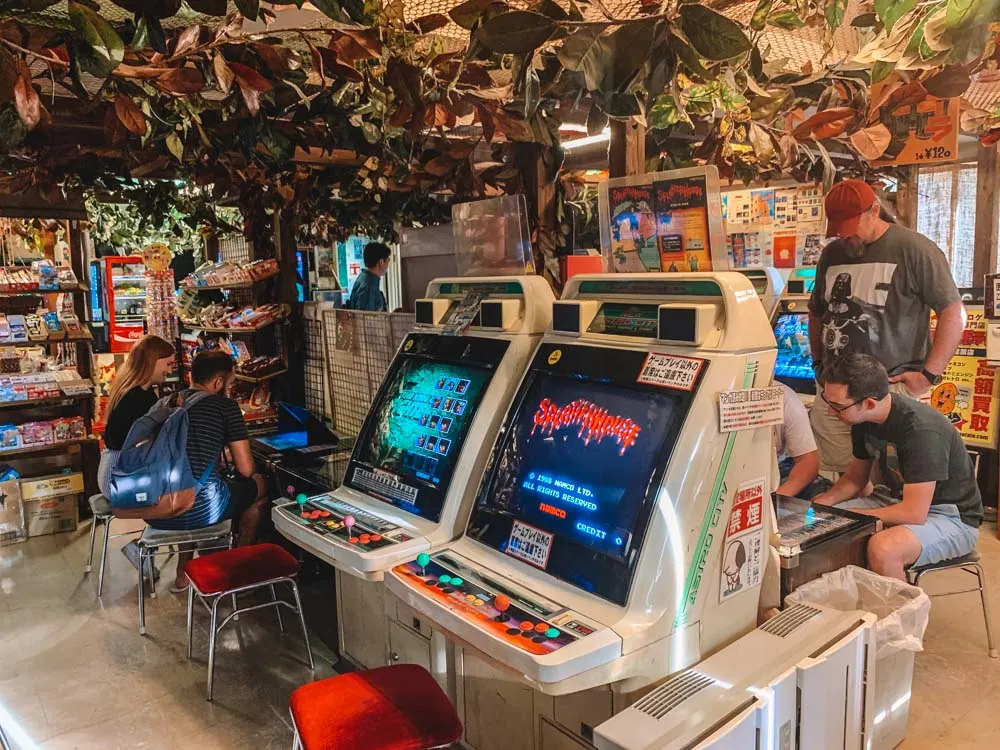
The top floor of Super Potato where you can play with vintage videogames
Day 2 in Tokyo
Shibuya
When you think of busy intersections and bustling crossroads, you probably think of New York.
But did you know that the Shibuya Crossing in Japan is said to be the busiest intersection in the world! Whether that’s true or not is up for debate, but it’s definitely the busiest in Japan.
During peak hours up to 3000 people cross at one time! For the best views of the intersection, head to the Starbucks across the road and watch the chaos from above.
This busy neighbourhood throws you into the depths of Tokyo’s business epicenter. Full of commuters in a hurry, the neighbourhood offers a glimpse into modern-day Tokyo.
If you want to make sure you don’t miss any of the important sights in Shibuya, and at the same time learn about Tokyo’s history, you can join a Shibuya walking tour.
Click here to book your Shibuya highlights walking tour!
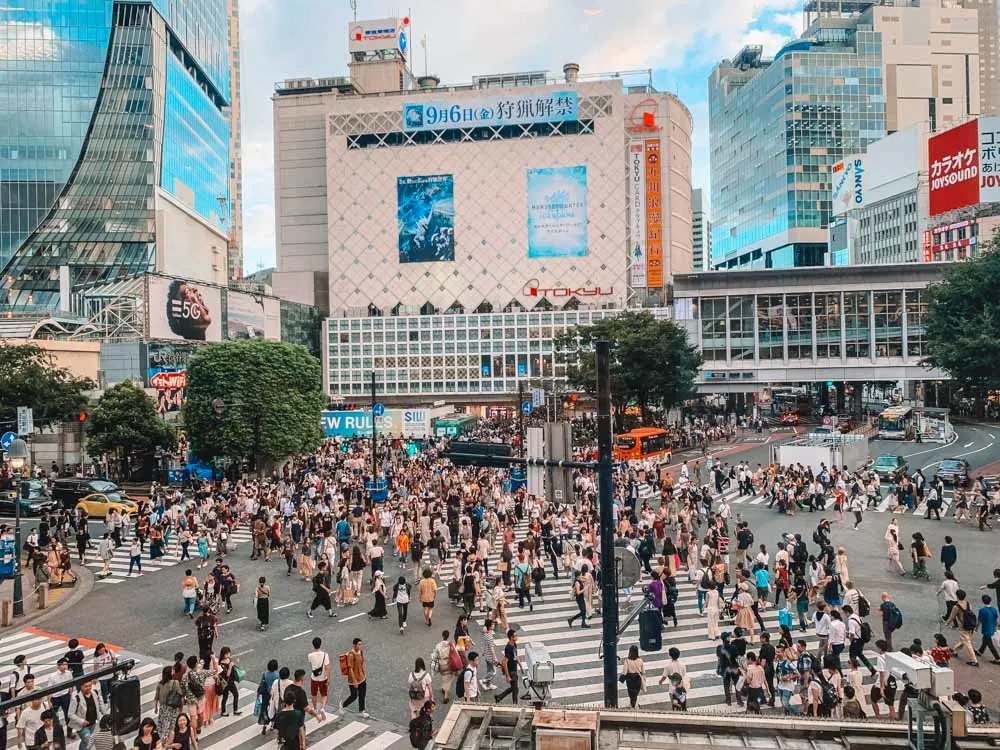
Shibuya crossing seen from the top floor of Starbucks in Tokyo

The busy streets of Shibuya, Tokyo, Japan, filled with pedestrians and bright city lights, capturing the energy of this famous urban district
While in Shibuya I had an amazing sushi lunch at Mawashizushi Katsu Seibu Shibuya Store. I enjoyed it as it was one of those sushi train restaurants, where you can see the sushi go past and pick off the belt the ones you like most.
Another great dining option in Shibuya is Ginza Steak Shibuya, where for 10,000 JPY you can have all you can eat Wagyu steak! Served in a Teppanyaki style restaurant, so you can see the chef as he prepares it for you.

Enjoying my wagyu dinner in Shibuya, Tokyo, Japan

Fresh, delicious, and colorful sushi in Tokyo, Japan
Whilst you’re in Shibuya also check out the Hachiko memorial statue.
The statue pays tribute to Akita, a dog who was alive in the 1920s. Each day, he would journey to Shibuya Station to wait for his owner to get back from his daily commute.
When his owner didn’t return one day due to a fatal cerebral hemorrhage, Hachiko kept coming back to the spot everyday for the next nine years.
The statue itself isn’t much, but the story is heartwarming and was the inspiration for the movie Hachi: A Dog’s Tale.
From the statue walk to Shibuya Station and hop on the Yamanote metro line to Shinjuku, and get out at Harajuku Station.

Hachiko Statue in Shibuya, Tokyo, Japan
Harajuku
Another popular area where manga is a central theme, Harajuku is a quirky neighbourhood with great street food. It was my favourite spot for sweet treats, like bubble tea, rainbow candy floss, and over-the-top doughnuts.
If you’re a sweet tooth you’ll love Harajuku.
Keep an eye out for the amazing street art as you wander around! There are masterpieces hidden in unexpected alleys and behind shop fronts.
The area is also great for vintage shopping. If you fancy buying something different, there are loads of unique cosplay shops along Takeshita Street.
Wander through the neighbourhood towards the next stop on the itinerary, the Meiji Jingu Shrine, just on the outskirts of Harajuku.
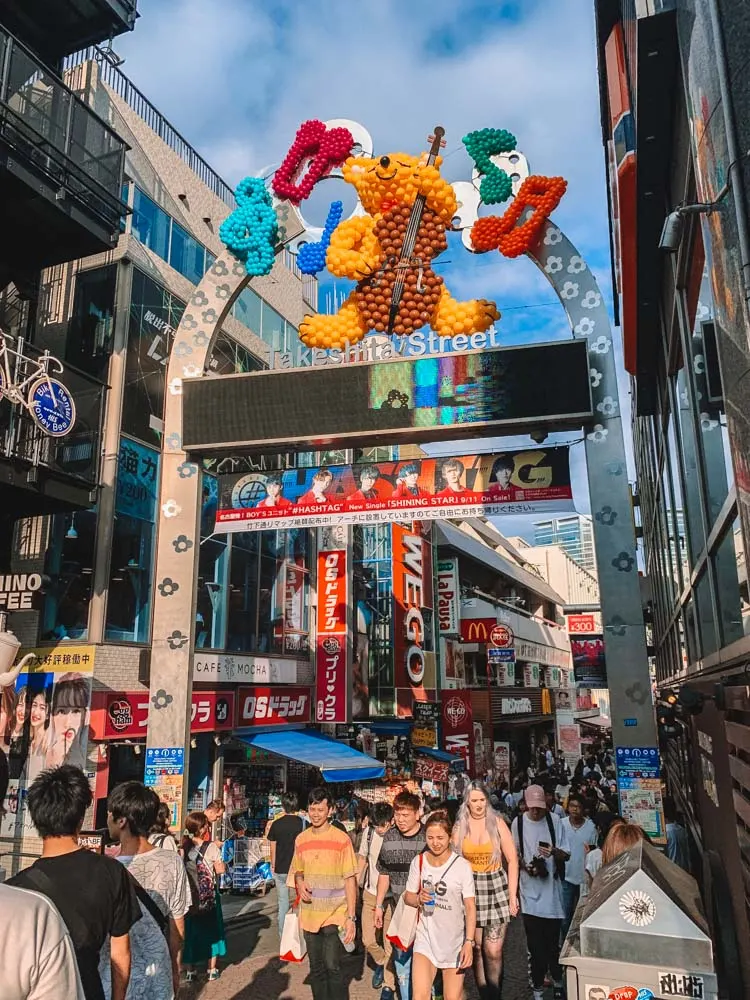
Takeshita street in Harajuku
Meiji Jingu Shrine
A meeting point of history and spirituality, the Meiji Jingu Shrine offers a refuge from the madness of the rest of the Shibuya neighborhood.
Built in 1920 in honour of the Emperor Meiji and Empress Shoken, the shrine pays tribute to two of Japan’s most influential leaders. The original shrine was destroyed during World War II, but rebuilt in 1958.
The shrine is also surrounded by a dense forest of more than 100,000 trees that nestle you out of the reach of the surrounding city noise. As you walk around the park, it almost doesn’t feel like you’re in Tokyo anymore!
When you’re ready to leave, wander back to the Harajuku Station and hop back on the Yamanote metro line to Shinjuku, but get off at Shinjuku Station this time.

The entrance road to Meiji Jingu Shrine in Tokyo, Japan, featuring a massive torii gate surrounded by lush greenery.

Sake barrels donated to the Meiji Jingu Shrine in Shibuya Tokyo, Japan
Shinjuku & Golden Gai
Another of Tokyo’s out-of-the-ordinary neighbourhoods, Shinjuku is a haven for shoppers and those searching for the city’s most bizarre streets and best nightlife.
You can’t miss Shinjuku’s Omoide Yokocho street, which is informally known as the piss alley. Despite its undesirable name, the street is actually pretty awesome.
Riddled with grubby outdoor food stalls, this narrow and dingy street is a stark contrast to the modern design of the rest of the city.
Enjoy a cold beer and let your mind wander as you watch life go by, away from the big roads and skyscapers.

Me at the Omoide Yokocho in Shinjuku Tokyo, Japan
Feel like continuing the night? Once you’ve had some food and a few cold beers, make your way to Shinjuku Golden Gai.
Known for its wild nightlife, the neighbourhood is an epicenter of karaoke and neon-lit clubs. But don’t worry, there are plenty of laid-back bars you can hang out at if you’re not in the mood to belt any top-hits out!
Shinjuku is a very hectic and lively part of Tokyo, that’s what makes it special, but if you feel overwhelmed by all the choices, you can also join a Shinjuku food tour, which takes you to 4 of the best places to eat in the area!
Click here to book your Shinjuku food tour!

Shinjuku, Tokyo, Japan, at night, with people walking along bustling streets illuminated by colorful neon signs
Day 3 in Tokyo
Tsukiji Fish Market
I couldn’t write a 3 days in Tokyo guide without including a trip to the Tsukiji Fish Market. Open from 5am till 2pm, start your day here and try some local dishes.
From sushi to fresh cooked fish, I’d recommend trying something a little different.
My top tip is that you don’t opt for an overpriced wagyu skewer that you can get anywhere for cheaper – try something wacky you haven’t come across before, like the uni (sea urchin) or chirashi bowls.
If you don’t like wandering aimlessly around markets, not knowing what food to try, you can join a Tsukiji Fish Market food tour. That way you’ll have a local guide taking you to all the best foodie spots!
Next, head to the TeamLab Borderless. To get there walk to the Tsukiji Station then hop on the Hibiya Line towards Naka-Meguro. Get out at Kamiyacho Station, just a three minute walk away from TeamLab Borderless.
Click here to book your Tsukiji Fish Market food tour!
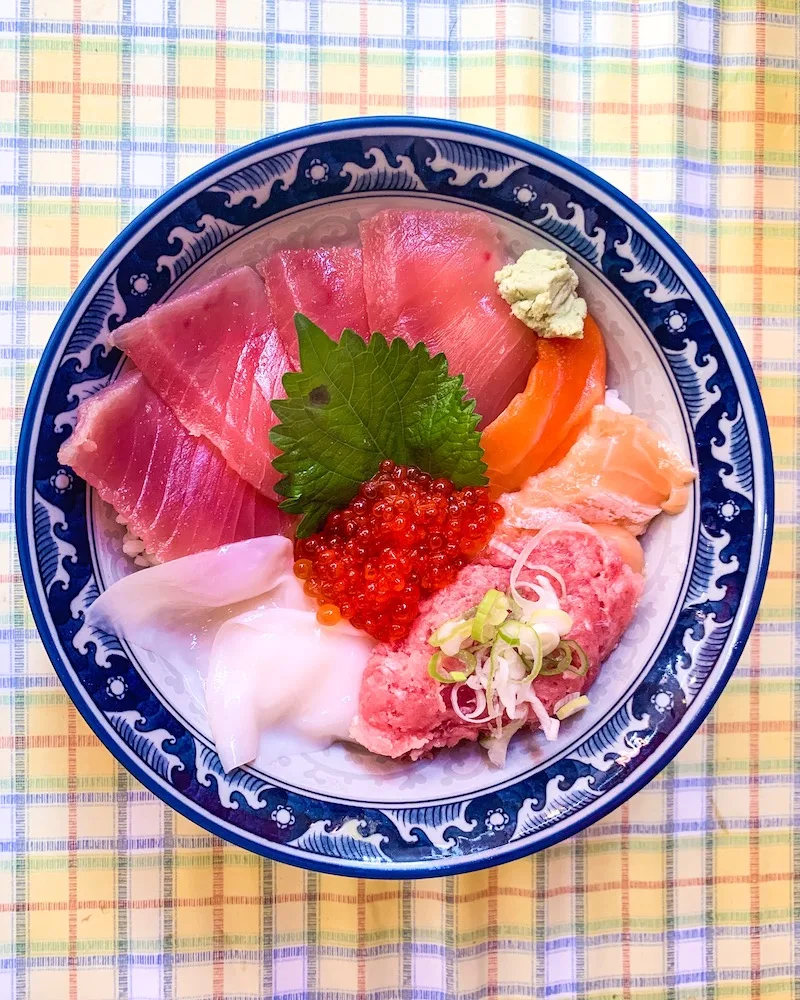
A very tasty chirashi bowl from Tsukiji fish market in Tokyo

The bustling Tsukiji Fish Market in Tokyo, Japan, filled with people exploring fresh seafood stalls and local vendors
TeamLab Borderless
This extraordinary museum really breaks the mold. It’s also ranked amongst the most Instagrammable places in Tokyo, and it’s easy to see why. But this extraterrestrial-like museum is far more than just a photo spot.
A collaborative project between the Digital Art Museum and Mori Building Company, the museum is a wild maze of colourful 3D visual displays and exhibits.
If I were you I’d try and get there just before the museum opens so you can be the first in and enjoy the museum all to yourself.
Even if there are lots of other people it won’t matter for most attractions, but some rooms you will have to queue for, and if you visit in the afternoon the wait will be so long it will make you want to skip them.
You can’t buy entrance on the door, you have to buy it online beforehand. It also tends to sell out fairly quickly, so make sure to buy it well in advance.
Click here to book your TeamLab Borderless entrance ticket!

Me at the Teamlab Borderless Museum in Roppongi, Tokyo, Japan
From here, the next stop of your Tokyo 3-day itinerary is Hie Shrine. You can easily walk there in just 25 minutes, or if you don’t want to walk, check out the public transport route below.
Head to the Kamiyacho Station and hop back on the Hibiya Line but towards Kita-Senju this time. Jump off at Kasumigaseki Station then get on the Chiyoda Line to Isehara and ride until the Kokkai-gijidomae Station.
From here it’s just a 5 minute walk to the Hie Shrine. It’ll take you about 15 minutes to get there overall if you opt for this public transport plus walking option.
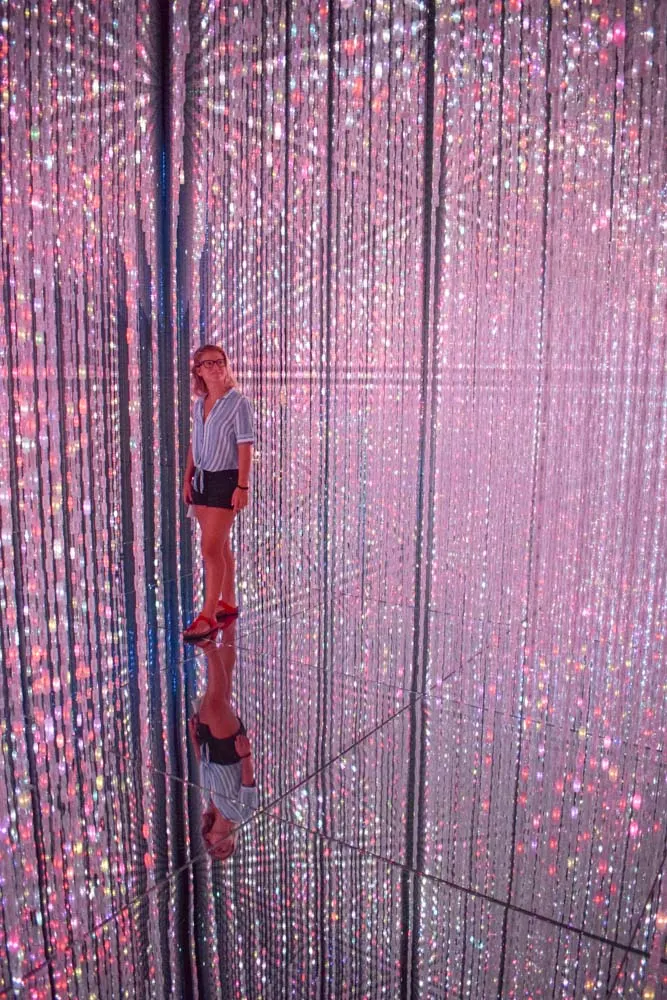
One of my favourite rooms at the Teamlab Borderless in Tokyo
Hie Shrine
Undeniably one of Tokyo’s most beautiful Shinto shrines, the Hie Shrine is picturesque and quintessentially Japanese. Surrounded by lush trees and vegetation, it’s easy to forget you’re in the heart of this busy city.
One of the main reasons people visit is actually because of the shrine’s unique entrances. The narrow stairway into Hie Shrine is lined by more than 90 bright red torii gates that form a sort of tunnel.
It looks very similar to the torii tunnel of Fushimi-Inari Taisha in Kyoto, but without the massive tourist crowds! Once you’ve snapped some photos of yourself, make your way to the Imperial Palace.

The vibrant red torii gates of Hie Shrine in Tokyo, Japan, creating a stunning pathway through the sacred site
Imperial Palace
Built on the former site of an Edo Castle, the Imperial Palace is found within a large park. Protected by a moat and big stone walls, the castle is sadly closed to the public. But you can admire it from afar and enjoy the surrounding gardens.
The castle is still the home of the Imperial Family today, so you could be just meters away from royalty.
For the most picturesque views of the castle, head to the Kokyo Gaien plaza. From there you’ll get views of the two Nijubashi Bridges and the palace.

A serene bridge at the Imperial Palace in Tokyo, Japan, with lush trees and a clear blue sky reflecting in the calm water
Omakase Dinner in Shimbashi
While you will probably have had loads of sushi during your three days around Tokyo, I wanted to specifically mention this area.
When I was searching for an omakase dinner in Tokyo, loads of restaurants that offered this unique Japanese dining experience seemed to be concentrated around Shimbashi station.
I had a set Omakase dinner menu at Sushidokoro Isseki Sancho for 13,000 JPY and loved it. It’s a bit on the pricier side, but it’s a unique Japanese experience that you’re guaranteed to enjoy, especially if you love sushi!
“Omakase” loosely translates to “I leave it up to you”, which means the chef will choose what sushi pieces to give you, usually based on what’s freshest or in season.
You eat at the counter, watching the chefs as they prepare the sushi for you.

A skilled sushi chef preparing sushi at an Omakase dinner in Tokyo, Japan, showcasing his craft and attention to detail
How To Get Around Tokyo
The great thing about Tokyo is that, unlike some cities, you can really rely on Google Maps. It’s super accurate and will give you up-to-date information about transport delays, traffic, and bus schedules.
Tokyo has an extensive network of trains, bus lines, and metro lines that makes it easy and convenient to get around.
I’d recommend getting yourself a Suica card for your 3 days in Tokyo. You can use the Suica card on trains, subways, and buses. Most of the destinations in this itinerary can be reached using the metro or on foot.
There are a number of day-pass tickets you can get, but it doesn’t tend to be financially worth it opting for these.
If you’re planning on mostly using the subway, you could also opt to get a Tokyo Subway Pass, which you can use on all the different Tokyo Metro lines.

Walking along the busy streets of Shibuya in Tokyo, Japan
Are 3 Days In Tokyo Enough?
Tokyo is the city with the highest population density in the world, and it consistently ranks amongst the biggest cities in terms of metropolitan area too. As you can imagine, it’s pretty big.
I think that trying to see all of Tokyo’s highlights in less than 3 days would be wildly ambitious.
Having spent some time there, I think 3 days in Tokyo is the bare minimum to see all the famous landmarks and top attractions.
Five days in Tokyo is preferable and what most Japan 2-week itineraries will include, as it gives you time also to go beyond Tokyo on a day trip to popular spots around the city, like Kamakura and Mt Fuji.
You could spend weeks there and still feel there’s more to do and see, but this Tokyo 3-day itinerary will take you to all the must-sees.
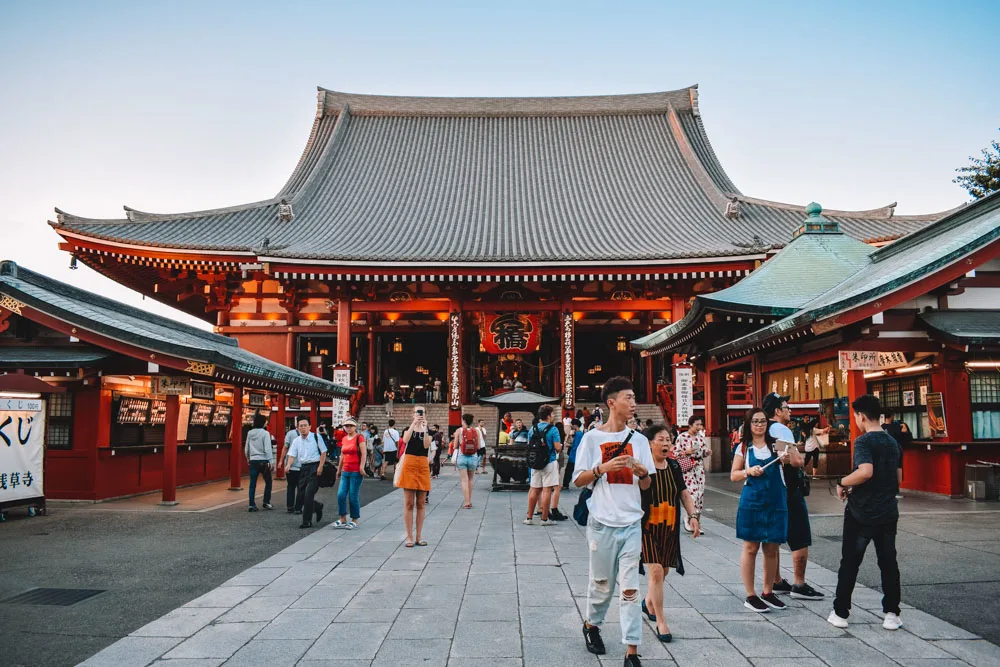
Senso-ji temple in Asakusa, Tokyo

Meiji Jingu Shrine in Tokyo, Japan, with visitors walking through the grounds beneath a rainbow in the sky
Where To Stay In Tokyo
Being such a massive city, there are loads of areas and places to stay in Tokyo, but the best one will depend on your budget and what vibe you’re looking for. Here are some suggestions.
Luxury
On my last Japan trip I stayed at these two beautiful luxury hotels, they were both incredible so I just had to include them both.
Let’s start with Park Hotel Tokyo. It’s an art hotel, with hundreds of pieces by Japanese artists all over the hotel, you will feel like you’re sleeping in an art gallery!
Plus the rooms and lobby have great views of Tokyo Tower, and on a clear day, even Mt Fuji! And the position is super central, which makes it a great base as you can easily travel all across Tokyo.
The next luxury hotel I couldn’t not mention is the Shiba Park Hotel Tokyo. Close to a variety of transport stations and offering an array of rooms, the hotel balances luxury and functionality.
It also has a cute lobby styled to feel like a library where you can relax and start the day with a fresh coffee.
Click here to book your stay at Park Hotel Tokyo!
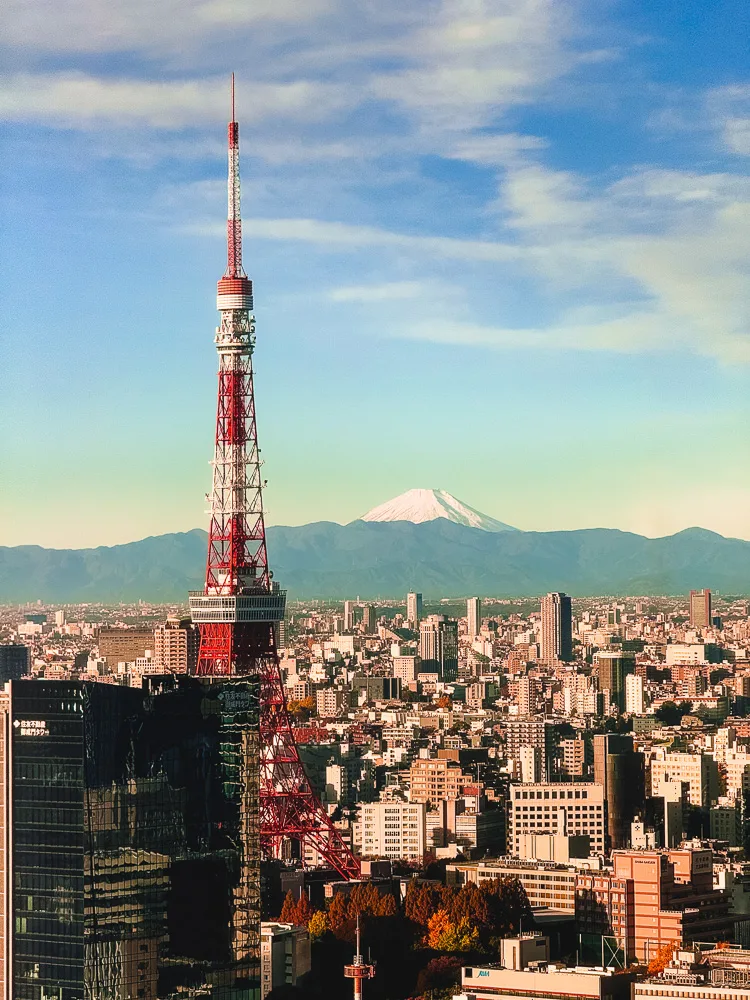
The view of Tokyo Tower and Mt Fuji as seen from my room at Park Hotel Tokyo in Japan
Midrange
For a great midrange option book a night at The Gate Hotel. This modern hotel has a cool rooftop bar with views of the SkyTree and Senso-ji! Perfect for those looking for a balance between price and vibe.
Click here to book your stay at The Gate Hotel!
Budget
Dormy Inn Premium has tidy and comfy rooms in the Shibuya neighbourhood. Perfect for those in Tokyo for 3 days on a budget. It is close to lots of train and metro stations, so you can easily get from there to the different attractions in this itinerary.
Another of the hotel’s perks? There is an onsen open to guests, so you can soak in the tub after a long day of exploring.
Click here to book your stay at the Dormy Inn Premium!

A stairway at the Shiba Park Hotel in Tokyo, Japan, featuring sleek, modern design and soft lighting
Best Time To Visit Tokyo
Tokyo is a city you can travel to year-round. The most popular seasons are spring, when the cherry blossoms are in full bloom, and autumn when the parks come to life in hues of reds and oranges.
However, these times are also the busiest and with most tourists. The weather is pretty mild year-round, so even if you go in winter you don’t need to worry about packing excessive winter gear.
Overall, the best times to go are March to May if you want to see the cherry blossom, or September to November if you want to catch the fall, but be ready to deal with big crowds!
If you visit outside the peak tourist seasons, like in winter or summer, don’t expect it to be empty. After all, it’s the biggest city in the world, there will still be crowds around you!
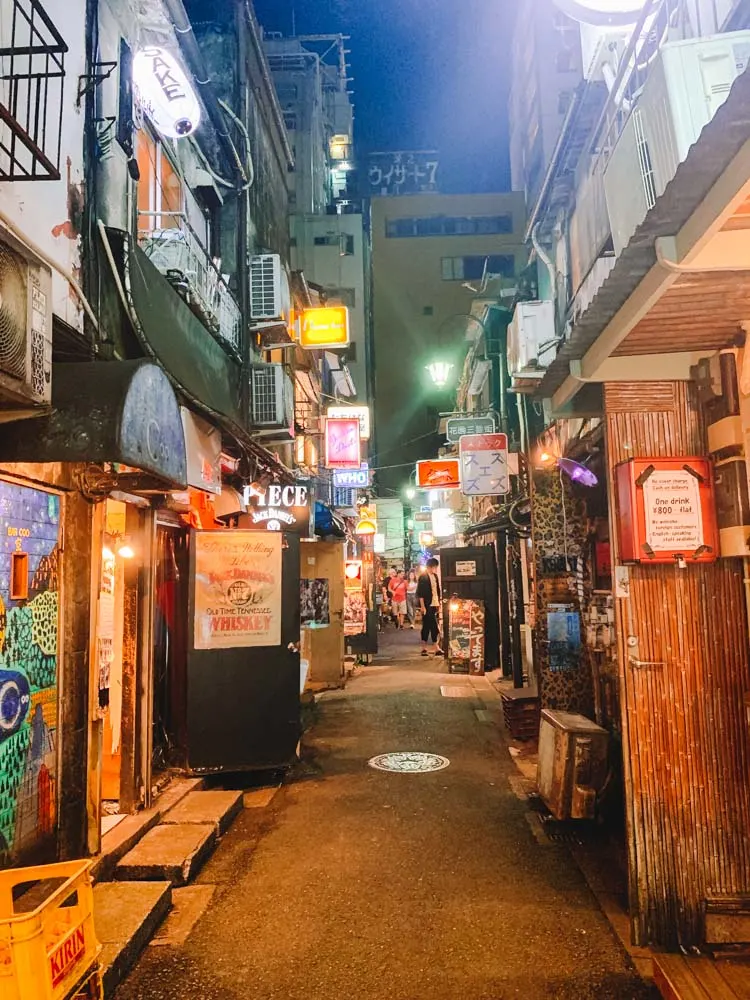
The streets and bars of Golden Gai in Shinjuku at night
Final Thoughts On My Tokyo 3-Day Itinerary
Tokyo’s mix of traditional and modern makes it a unique and fascinating city, which features on everyone’s Japan bucket list, and it’s easy to see why.
From bustling metropolitan areas to neighbourhoods filled with manga artifacts and endless street food stalls – the city always keeps you on your toes.
This Tokyo 3-day itinerary offers a combination of destinations that showcase the different aspects of this multifaceted city. Hop from temples to lively bars, or from Instagrammable digital museums to rejuvenating parks.
Personally, I love Tokyo. I find it one of the most exciting cities to explore, with its stark contrasts between modernity and tradition. But Japan isn’t just about big cities and neon lights.
Make sure to go beyond Tokyo, and explore ancient towns like those on the Nakasendo Highway, cute islands like Miyajima, and picturesque towns like Nara or Himeji. They will give you a great idea of the variety of Japan.
Has this 3 days in Tokyo Japan itinerary inspired you to go? Have you visited Tokyo before? Let me know in the comments below!
Enjoyed reading my 3 perfect days in Tokyo guide? Pin it!


